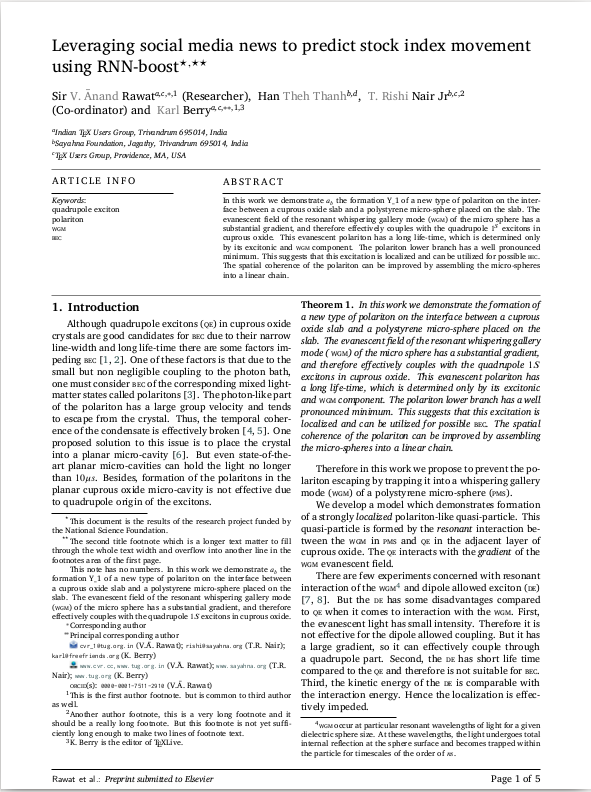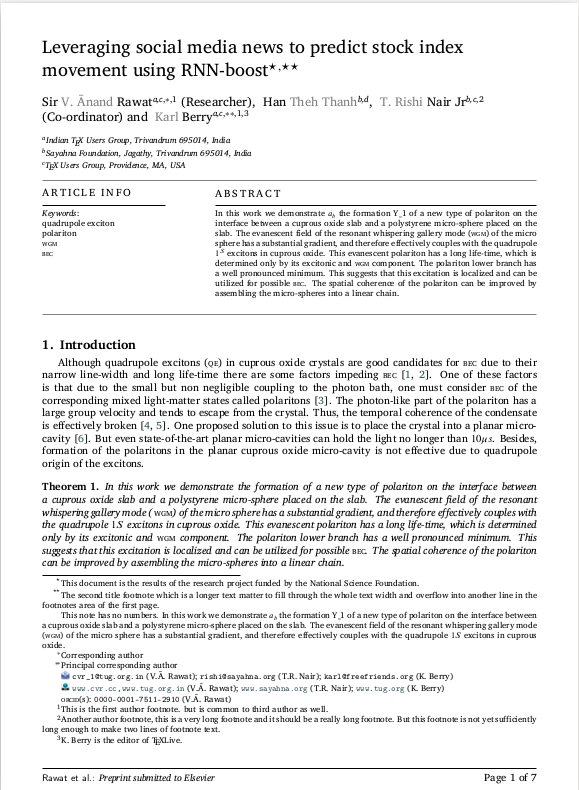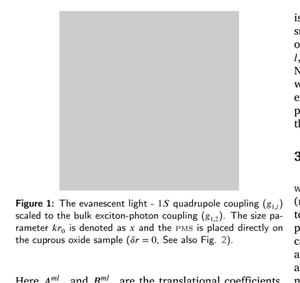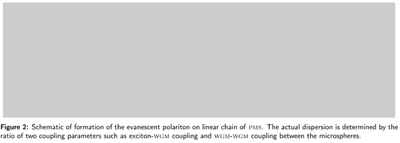Elsarticle - CAS
Elsarticle - CAS
Class files
Usage
There are two class files
cas-sc.clsfor single column journals.\documentclass[<options>]{cas-sc}
cas-dc.clsfor double column journals.\documentclass[<options>]{cas-dc}
and have an option longmktitle to handle long front matter.
Front matter
\title[mode = title]{Leveraging social media news to predict stock
index movement using RNN-boost}
\tnotemark[1,2]
\tnotetext[1]{This document is the results of the research project
funded by the National Science Foundation.}
\tnotetext[2]{The second title footnote which is a longer text
matter to fill through the whole text width and overflow into
another line in the footnotes area of the first page.}
\author[1,3]{V. {{\=A}}nand Rawat}[type=editor,
auid=000,bioid=1,
prefix=Sir,
role=Researcher,
orcid=0000-0001-7511-2910]
\cormark[1]
\fnmark[1]
\ead{cvr_1@tug.org.in}
\ead[url]{www.cvr.cc,www.tug.org.in}
\credit{Conceptualization of this study, Methodology, Software}
\address[1]{Indian \TeX{} Users Group, Trivandrum 695014, India}
\author[2,4]{Han Theh Thanh}[style=chinese]
\author[2,3] {T. Rishi Nair}[role=Co-ordinator,
suffix=Jr]
\fnmark[2]
\ead{rishi@sayahna.org}
\ead[URL]{www.sayahna.org}
\credit{Data curation, Writing - Original draft preparation}
\address[2]{Sayahna Foundation, Jagathy, Trivandrum 695014, India}
\author[1,3]{Karl Berry}
\cormark[2]
\fnmark[1,3]
\ead{karl@freefriends.org}
\ead[URL]{www.tug.org}
\address[3]{\TeX{} Users Group, Providence, MA, USA}
\cortext[cor1]{Corresponding author}
\cortext[cor2]{Principal corresponding author}
\fntext[fn1]{This is the first author footnote.
but is common to third author as well.}
\fntext[fn2]{Another author footnote, this is a very long footnote
and it should be a really long footnote. But this footnote is not
yet sufficiently long enough to make two lines of footnote text.}
\fntext[fn3]{K. Berry is the editor of \TeX Live.}
\nonumnote{This note has no numbers. In this work we demonstrate
$a_b$ the formation Y\_1 of a new type of polariton on the
interface between a cuprous oxide slab and a polystyrene
micro-sphere placed on the slab. The evanescent field of the
resonant whispering gallery mode (\WGM) of the micro sphere has a
substantial gradient, and therefore effectively couples with the
quadrupole $1S$ excitons in cuprous oxide.}
\begin{abstract}[S U M M A R Y]
In this work we demonstrate $a_b$ the formation Y\_1 of a new type
of polariton on the interface between a cuprous oxide slab and a
polystyrene micro-sphere placed on the slab. The evanescent field of
the resonant whispering gallery mode (\WGM) of the micro sphere has
a substantial gradient, and therefore effectively couples with the
quadrupole $1^S$ excitons in cuprous oxide. This evanescent
polariton has a long life-time, which is determined only by its
excitonic and \WGM component. The polariton lower branch has a well
pronounced minimum. This suggests that this excitation is localized
and can be utilized for possible \BEC. The spatial coherence of the
polariton can be improved by assembling the micro-spheres into a
linear chain.
\end{abstract}
\begin{keywords}
quadrupole exciton \sep polariton \sep \WGM \sep \BEC
\end{keywords}
\maketitle
Title
\title command have the below options:
title: Document titlealt: Alternate titlesub: Sub titletrans: Translated titletranssub: Translated sub title
\title[mode=title]{This is a title}
\title[mode=alt]{This is a alternate title}
\title[mode=sub]{This is a sub title}
\title[mode=trans]{This is a translated title}
\title[mode=transsub]{This is a translated sub title}
Author
\author command have the below options:
auid: Author idbioid: Biography idalt: Alternate authorstyle: Style of author namechineseprefix: PrefixSirsuffix: Suffixdegree: Degreerole: Roleorcid: ORCIDcollab: Collaborationanon: Anonymous authordeceased: Deceased authortwitter: Twitter accountfacebook: Facebook accountlinkedin: LinkedIn accountplus: Google plus accountgplus: Google plus account
\author[1,3]{Author Name}[type=editor,
auid=000,bioid=1,
prefix=Sir,
role=Researcher,
orcid=0000-0001-7511-2910,
facebook=<facebook id>,
twitter=<twitter id>,
linkedin=<linkedin id>,
gplus=<gplus id>]
|
Various Marks in the Front Matter
The front matter becomes complicated due to various kinds of notes and marks to the title and author names. Marks in the title will be denoted by a star (⋆) mark; footnotes are denoted by super scripted Arabic numerals, corresponding author by of an Conformal asterisk (*) mark.
Title marks
Title mark can be entered by the command, \tnotemark[<num>] and the corresponding text
can be entered with the command \tnotetext[<num>]{<text>}. An example will be:
\title[mode=title]{Leveraging social media news to predict
stock index movement using RNN-boost}
\tnotemark[1,2]
\tnotetext[1]{This document is the results of the research
project funded by the National Science Foundation.}
\tnotetext[2]{The second title footnote which is a longer text matter
to fill through the whole text width and overflow into
another line in the footnotes area of the first page.}
\tnotetext and \tnotemark can be anywhere in the front matter, but shall be before \maketitle
command.
Author marks
Author names can have many kinds of marks and notes:
- footnote mark :
\fnmark[<num>] - footnote text :
\fntext[<num>]{<text>} - affiliation mark :
\author[<num>] - email :
\ead{<emailid>} - url :
\ead[url]{<url>} - corresponding author mark :
\cormark[<num>] - corresponding author text :
\cortext[<num>]{<text>}
Other marks
At times, authors want footnotes which leave no marks in the author names. The note text
shall be listed as part of the front matter notes. Class files provides \nonumnote for this purpose.
The usage
\nonumnote{<text>}
and should be entered anywhere before the \maketitle command for this to take effect.
Abstract and Keywords
Abstract shall be entered in an environment that starts with \begin{abstract} and ends
with \end{abstract}. Longer abstracts spanning more than one page is also possible in
Class file even in double column mode. We need to invoke longmktitle option in the class
loading line for this to happen smoothly.
The key words are enclosed in a {keyword} environment.
\begin{abstract}
This is a abstract. \lipsum[3]
\end{abstract}
\begin{keywords}
First keyword \sep Second keyword \sep Third keyword \sep Fourth keyword
\end{keywords}
|
Main Matter
Tables
Normal tables
\begin{table}
\caption{This is a test caption.}
\begin{tabular*}{\tblwidth}{@{} LLLL@{} }
\toprule
Col 1 & Col 2\\
\midrule
12345 & 12345\\
12345 & 12345\\
12345 & 12345\\
12345 & 12345\\
12345 & 12345\\
\bottomrule
\end{tabular*}
\end{table}
|
Span tables
\begin{table*}[width=.9\textwidth,cols=4,pos=h]
\caption{This is a test caption.}
\begin{tabular*}{\tblwidth}{@{} LLLLLL@{} }
\toprule
Col 1 & Col 2 & Col 3 & Col4 & Col5 & Col6 & Col7\\
\midrule
12345 & 12345 & 123 & 12345 & 123 & 12345 & 123 \\
12345 & 12345 & 123 & 12345 & 123 & 12345 & 123 \\
12345 & 12345 & 123 & 12345 & 123 & 12345 & 123 \\
12345 & 12345 & 123 & 12345 & 123 & 12345 & 123 \\
12345 & 12345 & 123 & 12345 & 123 & 12345 & 123 \\
\bottomrule
\end{tabular*}
\end{table*}
|
Figures
Normal figures
\begin{figure}
\centering
\includegraphics[scale=.75]{Fig1.pdf}
\caption{The evanescent light - $1S$ quadrupole coupling
($g_{1,l}$) scaled to the bulk exciton-photon coupling
($g_{1,2}$). The size parameter $kr_{0}$ is denoted as $x$ and
the \PMS is placed directly on the cuprous oxide sample ($\delta
r=0$, See also Fig. \protect\ref{FIG:2}).}
\label{FIG:1}
\end{figure}
|
Span figures
\begin{figure*}
\centering
\includegraphics[width=\textwidth,height=2in]{Fig2.pdf}
\caption{Schematic of formation of the evanescent polariton on
linear chain of \PMS. The actual dispersion is determined by
the ratio of two coupling parameters such as exciton-\WGM coupling
and \WGM-\WGM coupling between the microspheres.}
\label{FIG:2}
\end{figure*}
|
Theorem and theorem like environments
CAS class file provides a few hooks to format theorems and theorem like environments with ease. All commands the options that are used with \newtheorem command will work exactly in the same manner. Class file provides three commands to format theorem or theorem like environments:
1. \newtheorem command formats a theorem in LaTeX’s default style with italicized font for theorem statement, bold weight for theorem heading and theorem number typeset at the right of theorem heading. It also optionally accepts an argument which will be printed as an extra heading in parentheses. Here is an example coding and output:
\newtheorem{theorem}{Theorem}
\begin{theorem}\label{thm}
The \WGM evanescent field penetration depth into the cuprous oxide
adjacent crystal is much larger than the \QE radius:
\begin{equation*}
\lambda_{1S}/2 \pi \left({\epsilon_{Cu2O}-1}\right)^{1/2} = 414 \mbox{
\AA} \gg a_B = 4.6 \mbox{ \AA}
\end{equation*}
\end{theorem}
|
2. \newdefinition command does exactly the same thing as with except that the body font is up-shape instead of italic. See the example below:
\newdefinition{definition}{Definition}
\begin{definition}
The bulk and evanescent polaritons in cuprous oxide
are formed through the quadrupole part of the light-matter
interaction:
\begin{equation*}
H_{int} = \frac{i e }{m \omega_{1S}} {\bf E}_{i,s} \cdot {\bf p}
\end{equation*}
\end{definition}
|
3. \newproof command helps to define proof and custom proof environments without counters as provided in the example code. Given below is an example of proof of theorem kind.
\newproof{pot}{Proof of Theorem \ref{thm}}
\begin{pot}
The photon part of the polariton trapped inside the \PMS moves as
it would move in a micro-cavity of the effective modal volume $V
\ll 4 \pi r_{0}^{3} /3$. Consequently, it can escape through the
evanescent field. This evanescent field essentially has a quantum
origin and is due to tunneling through the potential caused by
dielectric mismatch on the \PMS surface. Therefore, we define the
\emph{evanescent} polariton (\EP) as an evanescent light - \QE
coherent superposition.
\end{pot}
|
Enumerated and Itemized Lists
CAS class files provides an extended list processing macros which makes the usage a bit more user friendly than the default LaTeX list macros. With an optional argument to the \begin{enumerate} command, you can change the list counter type and its attributes.
You can see the coding and typeset copy.
\begin{enumerate}[1.]
\item The enumerate environment starts with an optional
argument ‘1.’ so that the item counter will be suffixed
by a period as in the optional argument.
\item If you provide a closing parenthesis to the number in the
optional argument, the output will have closing parenthesis
for all the item counters.
\item You can use ‘(a)’ for alphabetical counter and ’(i)’ for
roman counter.
\begin{enumerate}[a)]
\item Another level of list with alphabetical counter.
\item One more item before we start another.
\begin{enumerate}[(i)]
\item This item has roman numeral counter.
\item Another one before we close the third level.
\end{enumerate}
\item Third item in second level.
\end{enumerate}
\item All list items conclude with this step.
\end{enumerate}
|
Biography
Normal biography
\begin{biography}[tuglogo.png]{Biography}
The evanescent polariton provided by a single sphere gives the
time coherence necessary for the observable \BEC of the quadrupole
exciton. But the spatial coherence is limited to a small region
near the sphere. To improve the spatial coherence one has to
sacrifice the temporal coherence slightly by delocalizing the
corresponding \WGM. It can be done by using an array of spheres
aligned along the $z$ direction and separated by the distance
$\delta r_{0}$ (See Fig.\ref{FIG:2}).
\end{biography}
Custom biography
\bio[width=10mm,pos=l]{tuglogo.png}
\textbf{Another Biography:}
Recent experimental \cite{HARA:2005} and theoretical
\cite{DEYCH:2006} studies have shown that the \WGM can travel
along the chain as "heavy photons". Therefore the \WGM acquires
the spatial dispersion, and the evanescent quadrupole polariton
has the form (See Fig.\ref{FIG:3}):
\endbio









